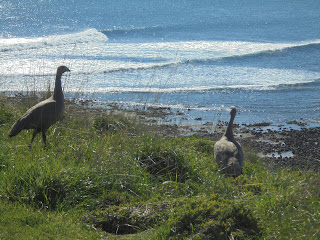We stayed at Tuileries, where we've stayed before. When I wanted to book for tea at 6.30, the girl at reception said they were fully booked, and we could not eat until 7. We arrived at 6.45, thinking we'd have a drink in the bar until our table was ready. Imagine our surprise to see that the restaurant was more than half empty! Not a good advertisement for Tuileries. Perhaps they had mass cancellations at the last minute.
 |
| Barmah Forest in flood |
On Wednesday, we drove to the Barmah forest, about two hours west of Rutherglen. It had rained here too, and there was a fair bit of flooding. I heard an oriole and decided to chase it down and get it onto my list. After a few minutes, I saw my bird. It was a Noisy Friarbird! This is not the first time I've been tricked by friarbirds. We took Kingfisher Cruises up the Murray, which was a very pleasant way to spend a couple of hours. I was delighted to see an Australian Reed-Warbler, my first for the year. On the way home, I saw five Emus, including two chicks, another first for 2018.
 |
| Kingfisher Cruises |
 |
| Cyanide dam was reduced to a muddy pool. |
It was a shame to have to come home on Friday, the first sunny day we'd had. I added Little Friarbird to the list, and then Brown Goshawk on the way home. In grey un-spring like weather, I had to be content with 93 species. There were some good birds on my list. The woodswallows were very welcome. The dollarbird was new for me in Rutherglen and the Little Eagle alone was worth the drive.


